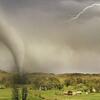According to the National Oceanic and Atmospheric Administration (NOAA), more than 1,200 tornadoes hit the United States each year. These violently rotating columns of air usually only last a few minutes, but they can be catastrophic events, lasting for more than an hour and traveling dozens of miles. Most of the world’s tornadoes occur in the United States and usually these natural hazards occur between April and June. Learn about how a tornado is formed, tornado impacts and reducing risk when a tornado occurs.
What Causes a Tornado?
The swirling, funnel-shaped winds of a tornado are easily recognizable — and they can be very dangerous. But what causes these unique and violent weather phenomena? NOAA SciJink explores the causes of tornadoes. NOAA SciJinks, created by the National Oceanic and Atmospheric Administration, provides a library of videos, activities, and articles about weather and Earth science!
The Science Behind Tornadoes
Tornadoes are one of the most powerful and violent weather phenomena. Although the details of tornado formation are still being researched, there are a few general steps to their formation. Video by the National Weather Service.
Anatomy of a Tornado
The Weather Channel’s Jim Cantore provides a step-by-step description and 3D view into how a tornado forms!
Tornado Safety
The Weather Channel meteorologist Alex Wilson showcases the power of tornados and provides safety tips with the help of a bit of immersive mixed reality.
Get Weather Ready: Tornadoes
If your area is under a tornado warning, would you know what to do to stay safe? You may only have a few minutes to get to safety. Knowing what actions to take when a tornado threatens your area is an important step in building a “Weather-Ready Nation,” according to the National Weather Service. Visit here for additional information on tornadoes and tornado safety.
More Tips for Tornado Safety

The National Weather Service offers a variety of resources on tornados, tornado preparedness and how to stay safe. If you know what to do before, during and after a tornado, you will minimize your risk of injury and increase your chances of survival. The National Weather Service also provides links to research, past events, and other topics of interest as well as downloadable safety handouts about thunderstorms, lightning, and tornadoes.

